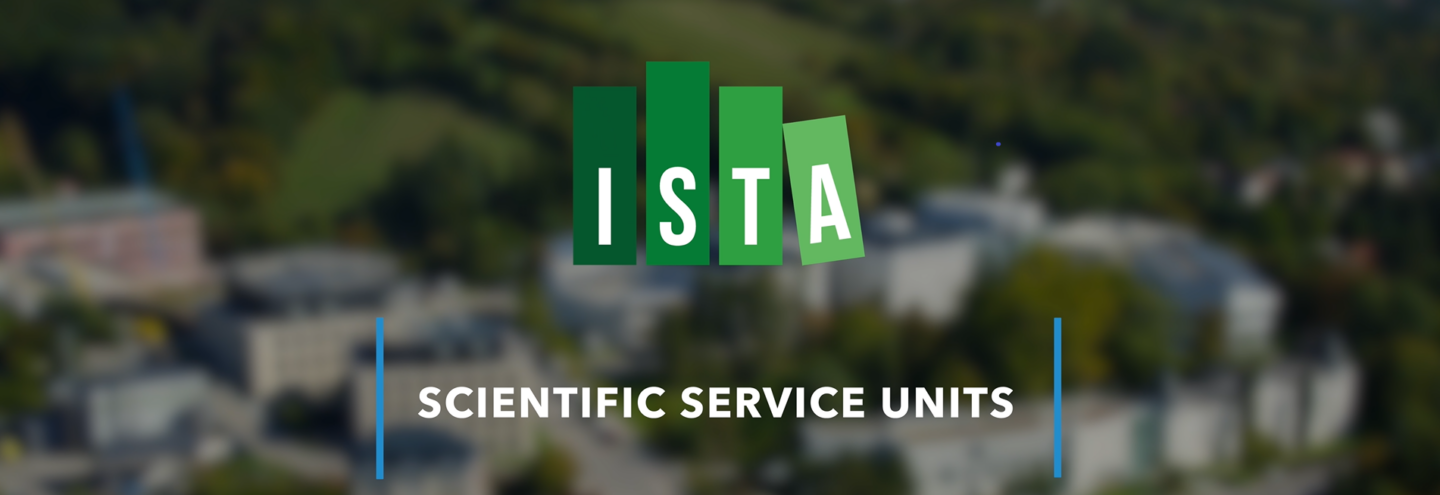Wissenschaftliche Services
Neun Einrichtungen stellen wissenschaftliche Infrastruktur am Campus zur Verfügung.
Die wissenschaftlichen Services (Scientific Service Units, SSUs) sind ein wichtiger strategischer Erfolgsfaktor des Institute of Science and Technology Austria (ISTA). Diese Einrichtungen stellen wissenschaftliche Infrastruktur möglichst vielen Forschungsgruppen zur Verfügung, um eine Verdoppelung des Aufwands und der Kosten zu vermeiden. Ihre hoch modernen Anlagen und Dienstleistungen ermöglichen Forschung auf international konkurrenzfähigem Niveau.

Im Lauf der Jahre sind die wissenschaftlichen Services auf mehr als 140 Mitarbeiter:innen in neun Einrichtungen angewachsen. Um die Bedürfnisse bestehender Forschungsgruppen und neuer ProfessorInnen abzudecken, sind sie stets um Anpassung und Ausbau ihrer Services bemüht. Ständiges Lernen sichert den Erwerb exzellenten Fachwissens für die Spitzenforschung.
Die wissenschaftlichen Services fungieren als interdisziplinäre Plattform, die gemäß dem Leitbild auf den gemeinsamen Einsatz von Geräten durch mehrere Forschungsgruppen abzielt.
Mondal S, Jethwa RB, Pant B, Hauschild R, Freunberger SA. 2024. Singlet oxygen in non-aqueous oxygen redox: Direct spectroscopic evidence for formation pathways and reliability of chemical probes. Faraday Discussions. 248, 175–189. View
Zavadakova A, Vistejnova L, Belinova T, Tichanek F, Bilikova D, Mouton PR. 2023. Novel stereological method for estimation of cell counts in 3D collagen scaffolds. Scientific Reports. 13(1), 7959. View
Huljev K, Shamipour S, Nunes Pinheiro DC, Preusser F, Steccari I, Sommer CM, Naik S, Heisenberg C-PJ. 2023. A hydraulic feedback loop between mesendoderm cell migration and interstitial fluid relocalization promotes embryonic axis formation in zebrafish. Developmental Cell. 58(7), 582–596.e7. View
Zeller P, Yeung J, Viñas Gaza H, de Barbanson BA, Bhardwaj V, Florescu M, van der Linden R, van Oudenaarden A. 2023. Single-cell sortChIC identifies hierarchical chromatin dynamics during hematopoiesis. Nature Genetics. 55, 333–345. View
Fäßler F, Javoor M, Datler J, Döring H, Hofer F, Dimchev GA, Hodirnau V-V, Faix J, Rottner K, Schur FK. 2023. ArpC5 isoforms regulate Arp2/3 complex–dependent protrusion through differential Ena/VASP positioning. Science Advances. 9(3), add6495. View
Pertl F, Sobarzo Ponce JCA, Shafeek LB, Cramer T, Waitukaitis SR. 2022. Quantifying nanoscale charge density features of contact-charged surfaces with an FEM/KPFM-hybrid approach. Physical Review Materials. 6(12), 125605. View
Prehal C, Mondal S, Lovicar L, Freunberger SA. 2022. Exclusive solution discharge in Li-O₂ batteries? ACS Energy Letters. 7(9), 3112–3119. View
Chang C, Liu Y, Lee S, Spadaro M, Koskela KM, Kleinhanns T, Costanzo T, Arbiol J, Brutchey RL, Ibáñez M. 2022. Surface functionalization of surfactant-free particles: A strategy to tailor the properties of nanocomposites for enhanced thermoelectric performance. Angewandte Chemie – International Edition. 61(35), e202207002. View
Medina Ramos RA. 2024. Exploring the optimization landscape of variational quantum algorithms. Institute of Science and Technology Austria. View
Raices J. 2024. Novel approaches to studying alternative splicing in Drosophila Melanogaster: Insights into sex-specific gene expression and the evolution of sex determination. Institute of Science and Technology Austria. View
Cheung GT, Streicher C, Hippenmeyer S. 2024. Protocol for quantitative reconstruction of cell lineage using mosaic analysis with double markers in mice. STAR Protocols. 5(3), 103157. View
Cheung GT, Pauler F, Koppensteiner P, Hippenmeyer S. 2024. Protocol for mapping cell lineage and cell-type identity of clonally-related cells in situ using MADM-CloneSeq. STAR Protocols. 5(3), 103168. View
Kohopää K, Ronzani A, Jabdaraghi RN, Bera A, Ribeiro M, Hazra D, Senior JL, Prunnila M, Govenius J, Lehtinen JS, Kemppinen A. 2024. Effect of ion irradiation on superconducting thin films. APL Materials. 12(7), 071101. View
![]()
Interreg V A Austria Czech Republic
Institute of Science and Technology Austria
c/o Scientific Service Units
Am Campus 1, A-3400 Klosterneuburg, Austria
Büro: Voestalpine building, Erdgeschoss
Email: ssu-office@ist.ac.at
